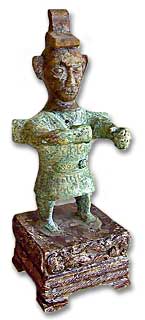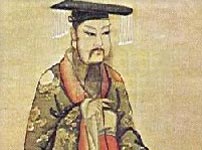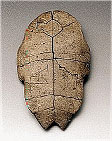The first recorded history of China begins with the Shang Dynasty between the 18th and 16th centuries B.C.E. Scholars debate the exact years the civilization began, but it is clear the Bronze Age that signaled the beginning of the dynasty. It marked the transition from a migratory society to a more stationary, agriculture-based way of living. Existing on the east of modern China in between the Yangtze and Yellow rivers, farming and husbandry thrived. The Shang were a skilled society recognized for their work in a number of mediums, including jade, bronze, bone, ceramics, and wood. It is on some of these bronze artifacts that archaeologists have discovered the earliest Chinese characters; often names written on the objects noting the individual to whom it belongs. Ten objects below will provide further insight into various aspects of the Shang culture.
This artifact is a ritual food vessel from the Shang Dynasty. The style, with three legs and two handles, was known as a ding. The artistry is shown on the body of the vessel where studded square patterns can be seen, as well as in the designs on the handles. Used more for ceremony than secular activity, the ding would often be buried with its owner, filled with food and wine as an offering to the ancestors. To be able to own a ding was a symbol of power and affluence in Shang society, especially in light of the legend of the founding of the dynasty; the nine dings of the Xia dynasty were taken by the Shang after they conquered, and the vessels represented the conquered wealth.
Oracle Bones serve as both a representation of early Chinese writing, and of Shang religion. Inscriptions on the bones include the names of deceased kings and ancestors, exemplifying the emphasis on ancestor worship in Shang religion. In addition to the writings found on the bones, historians have learned that priests used them, as the name suggests, as oracles. The priests would punch holes in the bones, then interpret the ensuing cracks. These oracle bones offer a glimpse at both early Chinese writing, and religion in the Shang Dynasty.
In addition to their skill in working with bronze, the Shang were masterful in their artistic uses of jade. As shown with this pendant, jade was often carved in the shapes of animal figures and faces. The jade carvings were numerous, with over 750 artifacts alone being discovered in one location (Fu Hao's tomb).

 Other objects, though their uses ambiguous, demonstrate the artistry and skill the Shang had with a variety of materials. This box (left) is made of marble, and the staff head (right) is, like the ding above, cast in bronze. The box shows well preserved detailing on the sides and corners, and the staff is in remarkably good condition, the animal face still clearly visible and intact. As the name "Bronze Age" suggests, bronze was the metal of choice during this era, and the number of discovered Shang artifacts in bronze fully demonstrate that.
Other objects, though their uses ambiguous, demonstrate the artistry and skill the Shang had with a variety of materials. This box (left) is made of marble, and the staff head (right) is, like the ding above, cast in bronze. The box shows well preserved detailing on the sides and corners, and the staff is in remarkably good condition, the animal face still clearly visible and intact. As the name "Bronze Age" suggests, bronze was the metal of choice during this era, and the number of discovered Shang artifacts in bronze fully demonstrate that. Religion in the Shang Dynasty combined mythological gods, animism, and ancestor worship. A polytheistic religion, it included various gods representing natural phenomena such as the sun, moon, wind, and rain. Ancestor worship, as well, was very important to the Shang. It was believed that happy ancestors could bring prosperity, while ancestors not properly worshiped would bring bad luck and misfortune.
Religion in the Shang Dynasty combined mythological gods, animism, and ancestor worship. A polytheistic religion, it included various gods representing natural phenomena such as the sun, moon, wind, and rain. Ancestor worship, as well, was very important to the Shang. It was believed that happy ancestors could bring prosperity, while ancestors not properly worshiped would bring bad luck and misfortune.
Closely linked with religion were the rulers, the kings, of the dynasty. Each King, they believed, was granted his power to rule through divine right. In addition, they had the important role to confer with Shangdi, the great god, who would bless them with wisdom and advice.
Note: All picture sources can be accessed by clicking the picture





No comments:
Post a Comment